Harvest Fall Vegetables for Delish Dishes

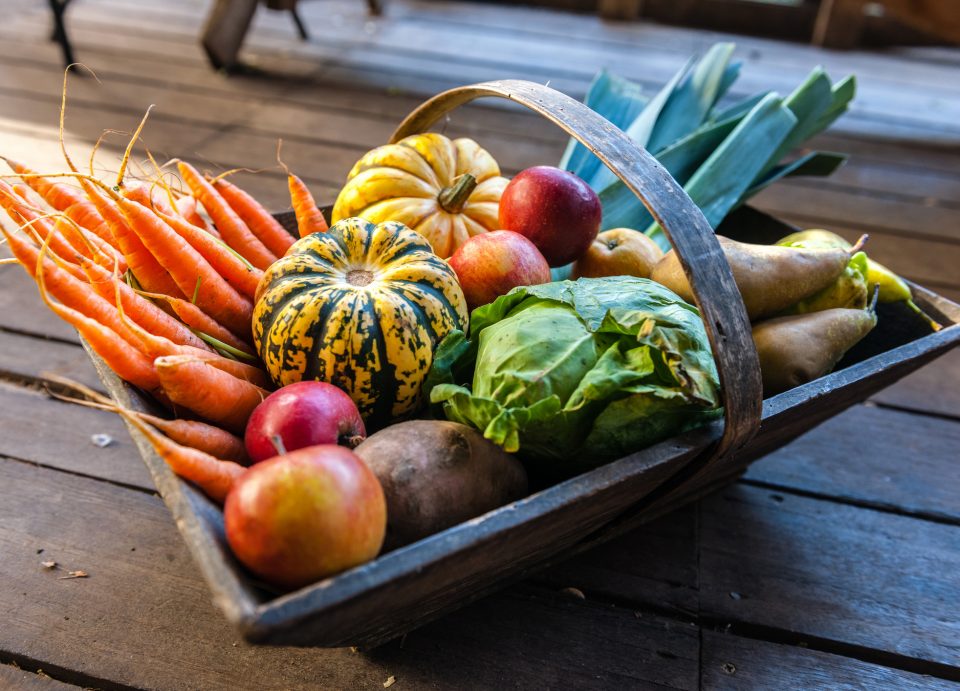
The change in season is such a wonderful time, even in temperate Southern California. Yes, the days can be hot, but the sun sets earlier and though it may still reach 80-plus degrees at 2:00 pm, evenings are cool, and thoughts turn to comforting, fallish foods, including vegetables. Most fall vegetables are available in winter, too, and most vegetables, for that matter, are available year-round thanks to farmers in Mexico and Central America. The key is that typically fall vegetables are at their peak this time of year, so take advantage of them at their best. Here are some vegetables to try and enjoy this fall season. Vegetables in general are full of valuable FoodTrients including vitamins, antioxidants, fiber, and minerals that all contribute to aging beautifully.
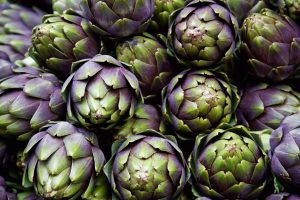 Artichokes
Artichokes
Artichokes enjoy a second crop in the fall (the first is in the spring). Fall produces small to medium artichokes, so everyone can have their own. Artichokes are rich in fiber, vitamins, minerals, and antioxidants. They’re high in folate and vitamins C and K. They also supply important minerals, such as magnesium, phosphorus, potassium, and iron. The classic way to enjoy artichokes is steamed, and then dip the leaves and heart in melted butter. But for a healthier alternative, make the ‘dip’ from extra virgin olive oil, balsamic vinegar, a drop of Dijon or spicy mustard, and a dash of salt.
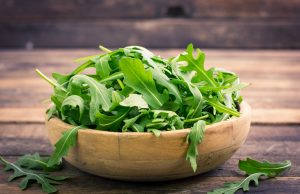 Arugula
Arugula
Arugula is a cool weather peppery green that grows well in many places during autumn. It’s actually a member of the cabbage and mustard green families, so it offers a good dose of antioxidants for protecting against damage to cells. The slightly bitter taste of arugula is due to the presence of glucosinolates, which may protect against certain cancers, including breast, prostate, lung, and colon cancers. My favorite go-to easy salad is about three cups arugula, two ripe tomatoes cut into small pieces, about a quarter cup of shaved Parmesan Reggiano, a couple of tablespoons of toasted pine nuts all tossed with extra virgin olive oil, and fresh lemon juice or balsamic vinegar. You can also toss arugula into most any pasta dish for added color and nutrition.
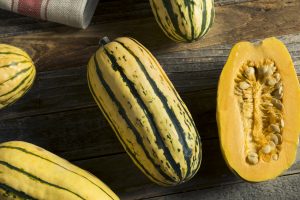 Delicata Squash
Delicata Squash
If you have never had Delicata squash, you’re in for a treat! About five-to-nine inches long and one-and- a-half to three inches in diameter, Delicata squash have a scalloped shape and beautiful green and orange stripes. The deep yellow to orange flesh tastes somewhere between a sweet potato and butternut squash. When roasted or steamed, even the skin is edible. To bring out their natural sweetness, cut into rings or chunks (discard the seeds or clean and roast those, too), toss with olive oil, a little salt, and roast for about 20-25 minutes at 400 degrees F. Delicata are also delicious stuffed with breadcrumbs, chestnuts, and herbs or cut into small chunks to be added to rice or cous-cous. Nutritionally they’re a good source of potassium, iron, and vitamins A and C.
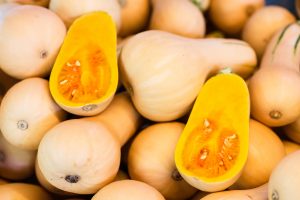 Honeynut Squash
Honeynut Squash
A recent addition to the fall/winter squash family, Honeynut squash was bred from butternut and buttercup squash in the 1980s. It has a similar shape and flavor to butternut squash but is about half the size and is considerably sweeter. It has dark tan to orange skin and orange fleshy pulp. It has two-to-three times more beta-carotene than butternut squash. Honeynut squash can be roasted, sautéed, puréed, added to soups, stews, and braises, and is even sweet enough for desserts.
Recipe: Honeynut Squash with Pecans and Pickled Shallots
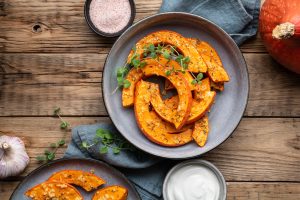 Serves 2-3
Serves 2-3
Ingredients:
1 Honeynut squash
1 shallot thinly sliced
2 tsp. apple cider vinegar
1 tsp. sugar
1/2 Tbs. butter
1 Tbs. honey
1/3 cup pecans
1/4 cup Greek yogurt
2 Tbs. cucumber, diced
1 pinch ground cumin
Procedure:
- Heat the oven to 425 degrees F.
- Carefully halve the Honeynut squash and scoop out the seeds.
- Drizzle with a bit of oil and season generously with salt and pepper.
- Roast in the oven, skin side up on a foil-lined baking sheet for 25-30 minutes, or until browned and tender.
- Once the squash has cooled enough to handle, slice each half lengthwise into about four pieces.
Quickly pickle the shallots:
- Place thinly sliced shallots in a small bowl with vinegar, sugar, and 2 Tbs. of water.
- Stir and let sit while you make the honeyed pecans.
Roast the pecans:
- In a small non-stick pan, melt the butter along with the honey over medium heat.
- Add the pecans and toss with the honey and butter until it bubbles and caramelizes.
- Remove the nuts from the pan and let cool completely
- In a small bowl, mix together the yogurt, cucumber, and a pinch of cumin. Taste and season with salt and pepper.
Spread onto a plate and add the squash on top. Garnish with the shallots and honeyed walnuts.
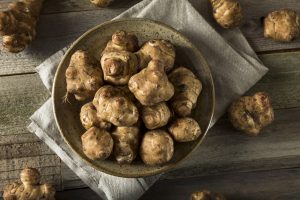 Jerusalem Artichoke/Sunchoke
Jerusalem Artichoke/Sunchoke
A sunchoke is the thickened underground part of the tuberous stem of a breed of sunflowers. Hence, the alternative name, sunchoke. This vegetable is mildly sweet, crunchy, and nutty, almost like a cross between potato and jicama. They’re available all year round, but best from October to May. Nutritionally, sunchokes are an excellent source of iron, potassium for regulating blood pressure, calcium, magnesium, and fiber. They can decrease blood cholesterol and are high in protein. They are also low in calories and are a good substitute for potatoes and other starchy root vegetables. Here’s an easy recipe:
Recipe: Roasted Sunchokes
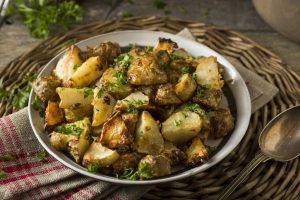
Serves 4
Ingredients:
2 pounds sunchokes, scrubbed
1 Tbs. olive oil
1 Tbs. soy sauce
2 cloves fresh garlic, coarsely chopped
1 Tbs. fresh lemon juice
Salt and freshly ground pepper to taste
¼ cup fresh Italian parsley, coarsely chopped for garnish
Instructions:
- Preheat oven to 375 degrees F.
- Cut sunchokes into 1 ½ -inch chunks.
- Toss on a baking sheet or roasting pan together with olive oil, soy sauce, garlic, and lemon juice coating well.
- Roast sunchokes for 35-to-45 minutes, or until soft and lightly golden brown.
- Season with a bit of extra salt and pepper, if desired.
- Garnish with the parsley
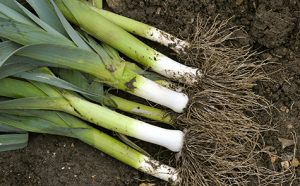 Leeks
Leeks
Leeks are in the allium family, so they’re related to garlic, chives, shallots, and onions. They have a sweet, oniony flavor that adds depth to soups, stews, and pasta dishes. Grilled or roasted, they make a delicious side dish. They’re at their best in the fall and spring. Nutritionally, leeks are rich in flavonoids. Flavonoids are antioxidants and studies suggest that they provide anti-inflammatory, anti-diabetic, and anticancer properties. The recipe below looks very refined and complicated, but it’s actually quite simple.
Recipe: Chicken with Leeks, Mushrooms and Parmesan Cheese
 Serves 4
Serves 4
Ingredients:
1 Tbs. avocado oil or grapeseed oil
4 chicken breasts, boneless, skinless, about 6 ounces each
Salt, to taste Freshly ground black pepper, to taste
1 Tbs. unsalted butter 4 leeks, cleaned, halved lengthwise, and cut into half-moon-shaped slices
8 cremini mushrooms, sliced or cut into quarters
1/3 cup vermouth, or white wine
3 Tbs. grated Parmesan Reggiano cheese
Instructions:
- Preheat the oven to 350 degrees F.
- Heat a large sauté pan over medium-high heat. Add the oil, making sure to coat the pan completely.
- Pat the chicken breasts dry with a paper towel and season on both sides with salt and pepper. Place them in the sauté pan. Cook each side for 5 minutes until slightly browned. Transfer the chicken to an ovenproof platter or pan and put it in the oven to finish cooking.
- Reduce the heat to medium-low and add the butter to the pan. When the butter melts, add the leeks and mushrooms; sauté, stirring occasionally, until both are softened, about 6 minutes.
- Remove the pan from the heat to add the vermouth, then return it to medium-low heat and cook until the vermouth is reduced by about half. Add the Parmesan cheese, stir and season to taste with salt and pepper.
- Remove the chicken breasts from the oven and check their internal temperature with a meat thermometer, which should be 165 degrees F. Let stand a few minutes before slicing chicken on the bias. Transfer chicken breasts to a dinner plate and top each with a generous spoonful of the cooked leeks and mushrooms.
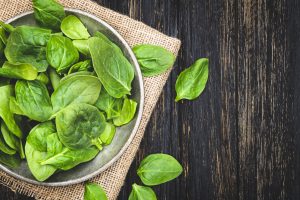 Spinach
Spinach
Spinach is a nutritious leafy green vegetable that originated in Persia. Interestingly, it belongs to the amaranth family, which includes beets and quinoa. Though available year round, the leaves are sweetest and most tender in the fall. Spinach is an excellent source of vitamins and minerals. It’s high in carotenoids, which your body can turn into vitamin A. It’s high in vitamin C, which is a powerful antioxidant that promotes skin health and immune function. It’s a good source of vitamin K1, which is essential for blood clotting. Just one spinach leaf holds over half of your daily needs! It also supplies folate or vitamin B9, which is vital for pregnant women and essential for normal cellular function and tissue growth. Spinach is an excellent source of iron, which helps to bring oxygen to your body’s tissues as well as calcium, which supports bone health and is crucial for your nervous system, heart, and muscles. These nutrients in spinach decrease oxidative stress, improve eye health, and help prevent heart disease and cancer. One of the most versatile vegetables out there, you can make spinach pesto, use it as a salad green, in place of lettuce on sandwiches (where it has the advantage of paring well with melted cheese and on other hot sandwiches), mixed into pasta dishes, soups, lentils, omelets, lasagna, dips, and flaky Greek pastries such as spanakopita.
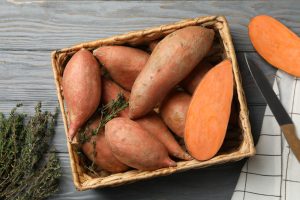 Sweet Potato
Sweet Potato
People frequently use the terms ‘yams’ and ‘sweet potatoes’ interchangeably. Yams have brown, rough bark-like skins and dry, white flesh while sweet potatoes are an entirely different vegetable. Sweet potatoes are elongated and have relatively smooth skins. Native to Central and South America, they come in a variety of colors including the familiar maroon skin with orange flesh, maroon with creamy white flesh, and purple with purple flesh. There are various combinations in between. Sweet potatoes are highly nutritious, containing a large amount of vitamin A and beta carotene (depending on color), calcium, protein, and fiber. Sweet potatoes are available year round (commercial growers can store them for months), but each year’s new crop is available in fall/winter. Sweet potatoes can be used as side dishes, as salads, and even for dessert. Many athletes roast them, slice them, and eat them as a snack after their run or workout. The following recipe can be a Thanksgiving side dish, but between you and me, it’s practically a dessert!
Recipe: Sweet Potato and Apple Casserole
 Serves 8-10
Serves 8-10
Ingredients:
4 pounds (about 6 large) sweet potatoes
½ cup freshly squeezed orange juice
½ cup heavy cream
½ stick of butter, melted
1/3 cup light brown sugar
1 tsp. ground nutmeg
½ tsp. cinnamon
¼ tsp. ground cayenne pepper
1 tsp. salt
¼ stick of butter
4 tart apples, McIntosh or Honeycrisp, peeled, cored, and cut into eighths
3 Tbs. light brown sugar
Procedure:
- Preheat oven to 375 degrees F.
- Scrub potatoes, then prick several times with a knife or fork.
- Bake for 1 hour, or until very soft when pierced with a knife.
- While the sweet potatoes are baking, combine orange juice, cream, melted butter, brown sugar, nutmeg, cinnamon, salt, and cayenne pepper.
- Remove potatoes from oven. Once cooled, scoop out the insides with a spoon. Place 1/2 of sweet potato meat into the bowl of an electric mixer. Add 1/2 of juice-and-cream mixture, blend until combined but not smooth, and pour into a large baking dish. Repeat with remaining potatoes and juice-and-cream mixture, then add to baking dish.
- Melt butter in a large skillet over medium-high heat. Add apple wedges and 3 Tbs. brown sugar; cook about 10 minutes, turning apples occasionally, until lightly browned on both sides.
- Place on top of sweet potatoes and bake 30 minutes, until heated through. More FoodTrients recipes.